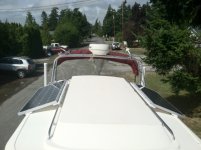Hey folks, quick question regarding solar panels etc.
I bought a 5W SunForce trickle charger solar panel and the instructions (yes, I read them!) say to disconnect from the battery before starting engine. I did not buy the 7W charging monitor etc.
I am assuming that this is to prevent damage to the panel from power back feeding to the panel when the engine is running and the batteries are charging?
I was planning on hard wiring the solar panel to my house battery but this is making me reconsider (I guess I could put a switch in the positive lead).
Any advice???
Peter
I bought a 5W SunForce trickle charger solar panel and the instructions (yes, I read them!) say to disconnect from the battery before starting engine. I did not buy the 7W charging monitor etc.
I am assuming that this is to prevent damage to the panel from power back feeding to the panel when the engine is running and the batteries are charging?
I was planning on hard wiring the solar panel to my house battery but this is making me reconsider (I guess I could put a switch in the positive lead).
Any advice???
Peter

